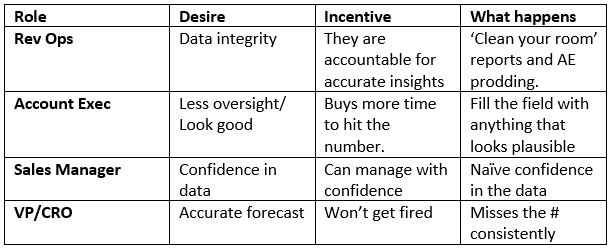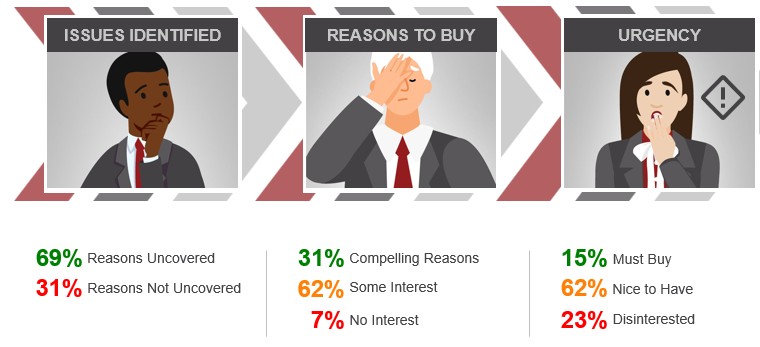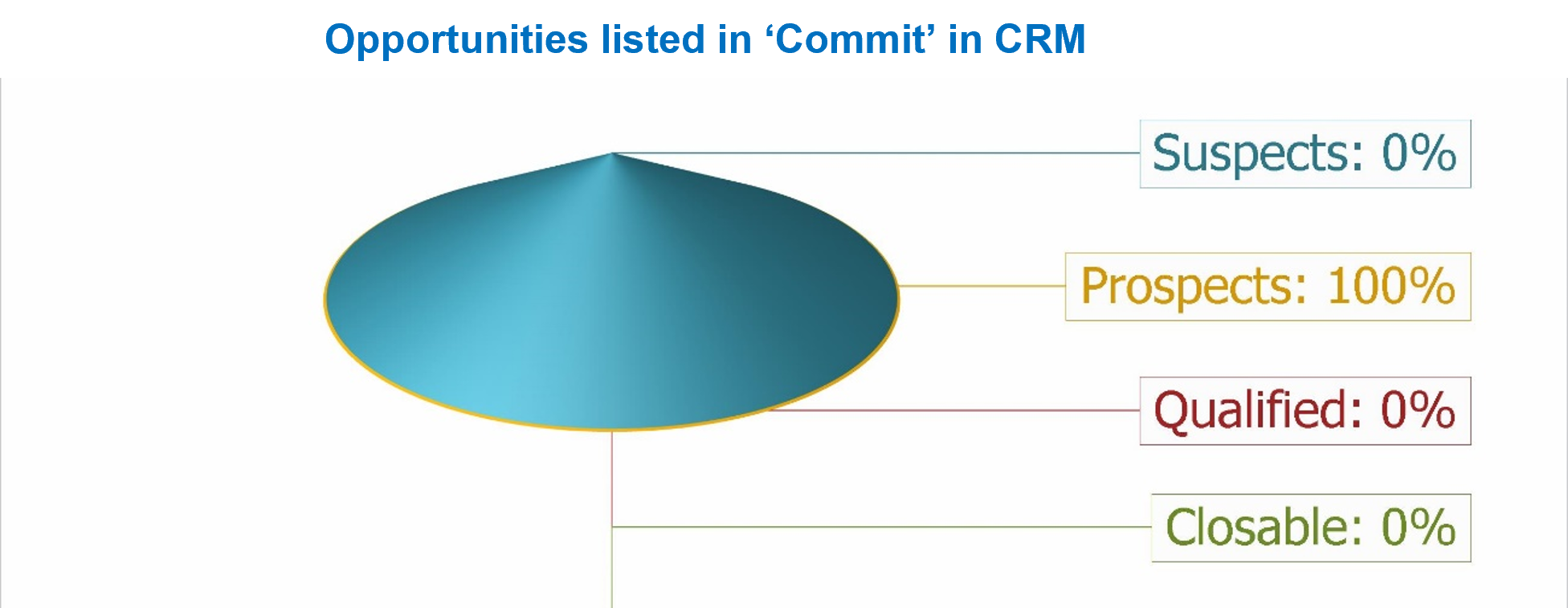Forgive me for the acronym salad – I couldn’t resist. For you Salesforce OGs, give me a ‘LIKE’ if you remember ‘OrebelSoft’ 🙂
Good intentions: You have paid a small fortune for one of the industry-leading sales methodology/process providers to roll out a new approach to increase deal sizes/win rates and shorten sales cycles.
Bad outcomes: Your notional deal sizes [“notional” because it is ‘fool’s gold’] went up, which led to greater ‘Commits’ to the exec/board, and your sales cycles didn’t change at all… Your AEs/Managers are holding onto losing deals for longer than before, because they were ‘Qualified’.
Sound horribly familiar? Read on and see a solution below:

Field completion does not a qualified opportunity make
There are a perverse set of incentives going on at each level of a revenue organization:

The incentives of each are at odds
Rev Ops/Sales Ops is often called, ‘The sales prevention office’ due to the focus on data entry/integrity for reps. The new savior is automated CRM updating [See below]. Being accountable for data integrity is a heavy burden, often resulting in a proliferation of CRM fields that inevitably get push-back from AEs and managers alike. The valid concern from this constituency is that your investment in ChallandlerMEDDSpiced is wasted if it isn’t in the CRM workflow and regularly inspected… They are not wrong. The issue is that AEs are time-poor and thereby incentivized to allocate as little time as possible to data:
Priority 1 = Fly the plane
Priority 2 = Communicate with the control tower
Here is an example of how it plays out:
AEs have been forced to enter qualification data into an opportunity before the CRM allows them to progress a stage… So they enter the data alright; it is just that it is meaningless.
Managers now have automated exception reports, and they see that no deals are out of spec, so with great confidence, they report their pipeline and forecast to the executive. They incorrectly assume that because we have trained the reps AND the data exists, the deals are in the state we think. Where they get tripped up is not understanding WHO the AEs received this information from and why they said what they did. “I am the decision maker, and I own the budget” – Perfect, we now know the Economic Buyer… Right? Right?
VP/CRO paid $250K-$1M for the ChallandlerMEDDSpiced rollout and promised that this would mean tight forecasts and up and to the right metrics (In fact, the ROI calculator from the vendor proved it beyond doubt). When they find that they missed a quarter without understanding why, they know they have one more quarter to figure it out before they will be ‘#OpenToWork‘ soon thereafter.
It could get worse with automation
Some very interesting tools automatically update CRM fields with qualification data – Sounds great in principle, but pause for a second and imagine this: A discovery call with the first buyer contact is completed, the tool automatically fills in:
- Pain points to solve
- The decision process
- The decision criteria
- The impact of doing nothing
- …
Now ask yourself these two questions:
1) Do we train our sellers to believe everything they hear from the first person they speak to, without any need for verification or skepticism? No.
2) Do you think that once these fields are completed, an AE will go and delete them and replace them with ‘Need to verify’, potentially triggering manager inspection? Yes, and there are fairies in my garden.
Having said this, I LOVE this next generation of tools, but they need to be used with care and the data given extra inspection.
To fix this you need to go beyond the data
One way to fix this is for managers to query the AEs on every deal at every stage and to verify every ChallandlerMEDDSpiced qualification metric. This gets you most of the way there, but these deal-check elements are still not the whole story. Secondly, this may be doable in enterprise segments, but we all know that managers just can’t do this at the scale needed for mid-market and transactional businesses.
Two years ago I came across a survey-based tool that allows you to quickly get to the root of any sales execution issue and diagnose how to fix it. Since then we have been running these exercises and helping organizations get back on track and really get adoption of their methodology investment.
It comes down to three areas of investigation:
Here is a real finding from a company we surveyed:

A methodology only works if you use it correctly – This is a real result from a client
Issues, reasons to buy and urgency are universal requirements for opportunity validity. In this example we found that 85% of all opportunities were either ‘zero interest’ or ‘nice to haves’. In 2023 ‘Nice to have’ is not getting past the CFO.
We then asked questions about deals in Commit. The graphic represents where they SHOULD have been:

Despite a ChallandlerMEDDSpiced implementation, these Commit deals were not even qualified!
So how do you get this insight?
Option 1: Hire a consultant to deep dive through your deal data and listen to a bunch of recorded calls to diagnose the situation. This will give you a reasonable proxy for what is going on, without individual coaching plans for each rep. This is fine for smaller orgs – It is what I would do if budgets are tight.
Option 2: Bring us in to run the assessment to get a virtual MRI of what is happening so that you can prescribe a ‘get-well’ plan and turn things around within a quarter.
If this sounds like something you want to explore, have a look here and scroll down to grab a time.
You can have a read about the science behind it here.



